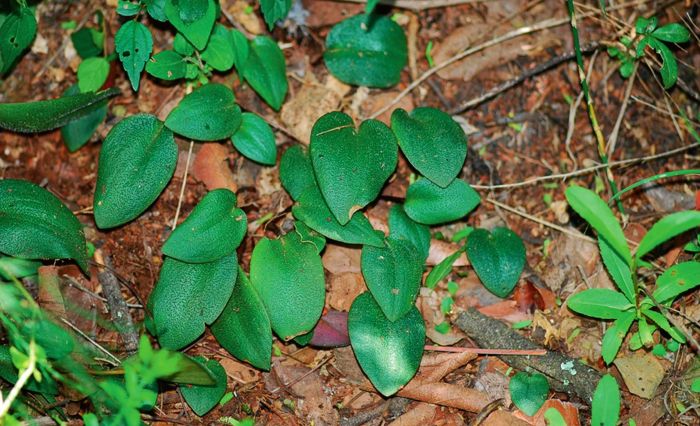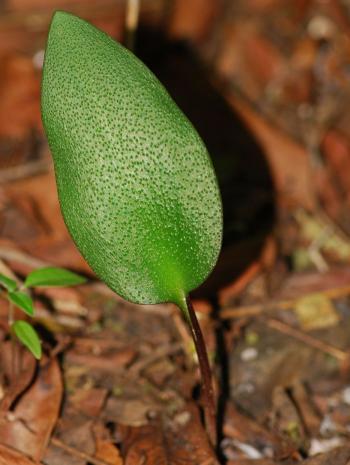Ledebouria loskopica
Ledebouria loskopica Hankey
Family: Hyacinthaceae
Common names: Loskop African hyacinth (Eng.)
Introduction
With its hairy leaves and strongly scented flowers, the Loskop African hyacinth was only recently formally recognized as a new species, despite being first collected in 1967.

Description
Description
Dwarf, deciduous, bulbous plants, 70 to 150 mm high, occurring as solitary individuals or in small groups of a few, to up to about twenty in loosely clustered groups; usually with a solitary unspotted hairy leaf, 30–60 mm long; the hairs are short and erect and mainly present on the upper surface. Small bulbs are 15–35 mm long. A slender solitary inflorescence (flower stalk) is produced from the bulb in spring and early summer (August to November), topped with a tightly arranged raceme of small purplish brown to greenish flowers. The flowers open only slightly when ready and are strongly hyacinth scented. The insignificant flowers are shortly followed by green seed capsules which split to release the small, dark brown, glossy seeds.

This species is most easily confused with other members of the section Drimiopsis which present hairy leaves. Most notably this species can be confused with L. linioseta which has the hairs arranged in neat longitudinal rows on both sides of the leaves, plus smaller more densely arranged flowers. The other species with which L. loskopica can be confused is L. atropurpurea which has leaves borne at the end of long, stalk-like leaf bases, with hairs on both surfaces of the leaves, and has purple flowers.
Conservation Status
Status
Ledebouria loskopica is not threatened in its natural range and has not yet been officially assessed for the Red List of South African plants. According to IUCN criteria, it qualifies as a Critically Rare species that is of conservation concern and should be monitored.
Distribution and habitat
Distribution description
This species is currently only known from a small isolated population in the Loskop Dam Nature Reserve in Mpumalanga Province of South Africa. The species occurs in stony soil under the canopy of trees, in sparse, open, mixed broadleaf woodland on the edge of seasonal drainage lines, amongst leaf litter, in the shade.

Derivation of name and historical aspects
History
This species was first collected by Prof. Theron (UP) in 1967 while conducting vegetation studies of the Loskop Dam Nature Reserve. The species was officially named as a new species by the author in 2020. The genus is named in honour of the German-Estonian botanist, Professor Carl Friedrich von Ledebour (1785–1851). The specific name, loskopica, is in reference to the Loskop Dam Nature Reserve where the species was first encountered.
South Africa has 58 species of Ledebouria, with several more species occurring across southern, western, east and northeast Africa and into India.

Ecology
Ecology
There is no documented information on the ecology specifically of Ledebouria loskopica. Porcupines are known to dig out and eat the bulbs of several species of Ledebouria and large ungulates have been observed to browse the leaves. Having hairs on the leaf may offer some advantage in terms of discouraging predation by insects. The plants occur in a relatively hot and dry vegetation type and have been observed to go dormant in the middle of the growing season if conditions become unsuitable.
This species possesses typical Drimiopsis-type flowers in which the outer tepals (petals) only open slightly and don’t become reflexed, whereas the inner tepals remain closed even when the flowers are open. Observations have been made of various pollinators including small solitary bees, small flies and wasps visiting the flowers when they are open. The visiting pollinators need to physically open the inner 3 tepals (petals) in order to gain access to the centre of the flower where the pollen and nectar is located. The flowers are strongly hyacinth scented, especially in the warmer parts of the day. The inflorescences are mostly erect becoming somewhat flaccid (floppy) with age, this may assist to with optimizing visibility of the flowers to attract pollinators. The seed is small black and roundish with a wrinkled surface. Venter (1993) suggests that Ledebouria seeds may be distributed by water wash, which is likely after heavy thunderstorms, which are frequent across the areas where the species occurs.
Uses
Use
There are no known or recorded medicinal or cultural uses specifically of the Loskop African hyacinth. Ledebouria has been cited as having been used medicinally for various purposes including pregnancy, diarrhoea, influenza, backache, skin irritations, wound treatment, as well as lumbago. The genus is also reported as being poisonous, although it is also reported that Bushmen ate the bulbs of certain species, including L. revoluta and L. apertiflora. However, these may have been cooked or prepared in some manner to destroy the toxins, which is not specifically documented. Despite the fact that some large ungulates do browse the leaves, the entire genus should be regarded as being poisonous as a precaution.

Growing Ledebouria loskopica
Grow
The Loskop African hyacinth is easily cultivated. They are well suited to containers because of their small size. Bulbs should be cultivated outdoors in terracotta pots in semi-shade, in a warm climate.
Plant the bulbs in sandy loam soil or a well-drained potting medium rich in organic matter, with some sifted, well-aged kraal (cattle) manure or mature compost added. Watering should be limited to the warm summer growing season. Pots should be allowed to be completely dried out during the winter rest period. Plants can withstand cold temperatures in winter, providing the soil is kept completely dry and the bulbs are dormant.
The pots should be moved out of the rain during the dormant winter season, and kept in a dry position with good air movement. Summer growth is initiated in spring by the onset of warmer temperatures or light rain (September to October). Emergence of the flowers is usually simultaneous with the leaves. Watering can commence as soon as the leaves break through the soil surface.
In cultivation adult plants can become afflicted with scale insect and mealy bug (including on the roots) especially if the cultural conditions are not ideal. Both of these maladies can be managed with a contact or systemic insecticide. Ants will often bring and spread such infestations and as such, it is best to manage ant populations where the plants are housed.
Ledebouria loskopica is easily propagated from fresh seed (seed cannot be stored for longer than 1 year). Seed should be sown in spring or summer. Sow seed on a finely sifted surface of the same growing medium, in pots or trays. Press seeds lightly into the soil and cover with a fine layer of approx. 2–3 mm of the sifted medium. Water weekly and keep in a warm and protected position out of direct sunlight. Seeds usually germinate within 2–3 weeks after which watering should be reduced depending on rainfall. Bulblets can be allowed to remain in their natal container for the first year, after which they can be planted out into individual or community pots. Flowering can begin at 2–3years from seed.
References
- Hankey, A. 2020. Ledebouria loskopica a new endemic species from Loskop Dam Nature Reserve, Mpumalanga, South Africa. Cactus and Succulent Journal 92(2): 118–122.
- Hankey, A.J. 2019. Proposed English common names for African hyacinths (genus Ledebouria). Plantlife SA, Vol 47:7 https://plantlifesouthafrica.blogspot.com/
- Jessop, J.P. 1970. Studies in the bulbous Liliaceae in South Africa: 1. Scilla, Schizocarpus and Ledebouria. Journal of South African Botany 36(4): 233–266.
- Wikipedia. Carl Friedrich von Ledebour. http://en.wikipedia.org/wiki/Carl_Friedrich_von_Ledebour. Accessed 6 November 2018.
Credits
Andrew Hankey
Walter Sisulu National Botanical Garden
November 2020
Plant Attributes:
Plant Type: Bulb
SA Distribution: Mpumalanga
Soil type: Clay, Loam
Flowering season: Spring, Early Summer
PH: Neutral
Flower colour: Brown, Purple, White
Aspect: Shade, Morning Sun (Semi Shade), Afternoon Sun (Semi Shade)
Gardening skill: Easy
Special Features:
Horticultural zones









Rate this article
Article well written and informative
Rate this plant
Is this an interesting plant?
Login to add your Comment
Back to topNot registered yet? Click here to register.